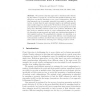Free Online Productivity Tools
i2Speak
i2Symbol
i2OCR
iTex2Img
iWeb2Print
iWeb2Shot
i2Type
iPdf2Split
iPdf2Merge
i2Bopomofo
i2Arabic
i2Style
i2Image
i2PDF
iLatex2Rtf
Sci2ools
ECCV
2010
Springer
2010
Springer
Crowd Detection with a Multiview Sampler
Abstract. We present a Bayesian approach for simultaneously estimating the number of people in a crowd and their spatial locations by sampling from a posterior distribution over crowd configurations. Although this framework can be naturally extended from single to multiview detection, we show that the naive extension leads to an inefficient sampler that is easily trapped in local modes. We therefore develop a set of novel proposals that leverage multiview geometry to propose global moves that jump more efficiently between modes of the posterior distribution. We also develop a statistical model of crowd configurations that can handle dependencies among people and while not requiring discretization of their spatial locations. We quantitatively evaluate our algorithm on a publicly available benchmark dataset with different crowd densities and environmental conditions, and show that our approach outperforms other state-of-the-art methods for detecting and counting people in crowds.
| Added | 02 Jul 2010 |
| Updated | 02 Jul 2010 |
| Type | Conference |
| Year | 2010 |
| Where | ECCV |
Comments (0)

